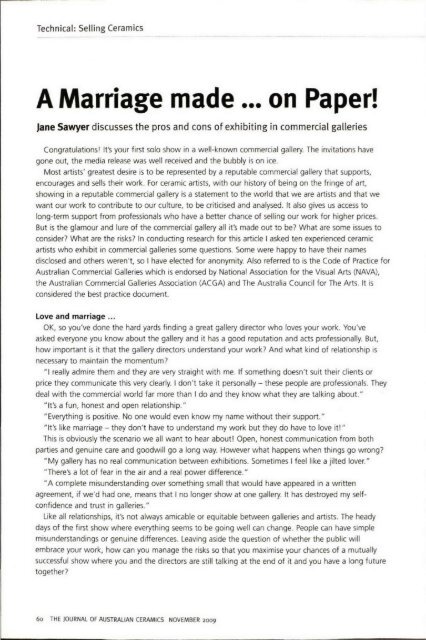The Journal of Australian Ceramics Vol 48 No 3 November 2009
You also want an ePaper? Increase the reach of your titles
YUMPU automatically turns print PDFs into web optimized ePapers that Google loves.
Technical: Selling Cera mics<br />
A Marriage made ... on Paper!<br />
Jane Sawyer discusses the pros and cons <strong>of</strong> exhibiting in commercial galleries<br />
Congratulations! It's your first solo show in a well-known commercial gallery. <strong>The</strong> invitations have<br />
gone out, the media release was well received and the bubbly is on ice.<br />
Most artists' greatest desire is to be represented by a reputable commercial gallery that supports,<br />
encourages and sells their work. For ceramic artists, with our history <strong>of</strong> being on the fringe <strong>of</strong> art,<br />
showing in a reputable commercial gallery is a statement to the world that we are artists and that we<br />
want our work to contribute to our culture, to be criticised and analysed. It also gives us access to<br />
long-term support from pr<strong>of</strong>essionals who have a better chance <strong>of</strong> selling our work for higher prices.<br />
But is the glamour and lure <strong>of</strong> the commercial gallery all it's made out to be? What are some issues to<br />
consider? What are the risks? In conducting research for this article I asked ten experienced ceramic<br />
artists who exhibit in commercial galleries some questions. Some were happy to have their names<br />
disclosed and others weren 't, so I have elected for anonymity. Also referred to is the Code <strong>of</strong> Practice for<br />
<strong>Australian</strong> Commercial Galleries which is endorsed by National Association for the Visual Arts (NAVA),<br />
the <strong>Australian</strong> Commercial Galleries Association (ACGA) and <strong>The</strong> Australia Council for <strong>The</strong> Arts. It is<br />
considered the best practice document.<br />
love and marriage ...<br />
OK, so you've done the hard yards finding a great gallery director who loves your work. You 've<br />
asked everyone you know about the gallery and it has a good reputation and acts pr<strong>of</strong>essionally. But,<br />
how important is it that the gallery directors understand your work) And what kind <strong>of</strong> relationship is<br />
necessary to maintain the momentum?<br />
"I really admire them and they are very straight with me. If something doesn't suit their clients or<br />
price they communicate this very clearly. I don't take it personally - these people are pr<strong>of</strong>essionals. <strong>The</strong>y<br />
deal with the commercial world far more than I do and they know what they are talking about. "<br />
"It's a fun, honest and open relationship."<br />
"Everything is positive. <strong>No</strong> one would even know my name without their support. "<br />
"It's like marriage - they don't have to understand my work but they do have to love it!"<br />
Th is is obviously the scenario we all want to hear about! Open, honest communication from both<br />
parties and genuine care and goodwill go a long way. However what happens when things go wrong?<br />
"My gallery has no real communication between exhibitions. Sometimes I feel like a jilted lover."<br />
"<strong>The</strong>re's a lot <strong>of</strong> fear in the air and a real power difference."<br />
"A complete misunderstanding over something small that would have appeared in a written<br />
agreement, if we'd had one, means that I no longer show at one gallery. It has destroyed my selfconfidence<br />
and trust in galleries."<br />
Like all relationsh ips, it's not always amicable or equitable between galleries and artists. <strong>The</strong> heady<br />
days <strong>of</strong> the first show where everything seems to be going well can change. People can have simple<br />
misunderstandings or genuine differences. Leaving aside the question <strong>of</strong> whether the public will<br />
embrace your work. how can you manage the risks so that you maximise your chances <strong>of</strong> a mutually<br />
successful show where you and the directors are still talking at the end <strong>of</strong> it and you have a long future<br />
together?<br />
60 THE JOURNAL OF AUSTRALIAN CERAMICS NOVEMBER <strong>2009</strong>


















